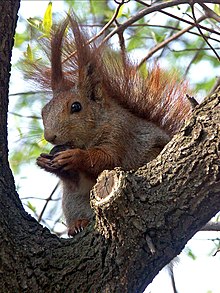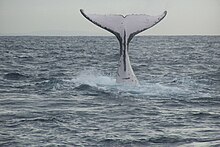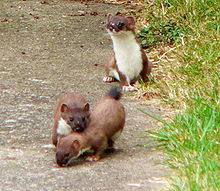bio.wikisort.org - Animal
There are 27 mammal species native to Ireland or naturalised in both the Republic of Ireland and Northern Ireland before 1500. The Red List of Irish terrestrial mammals was updated in 2019, with assessments of these 27 species. One species is locally extinct, one is vulnerable and 25 are least concern species. Not assessed were nine mammal species that were introduced after 1500.[1]
The following tags are used to highlight each species' conservation status as assessed on the IUCN Red List:
| EX | Extinct | No reasonable doubt that the last individual has died. |
| EW | Extinct in the wild | Known only to survive in captivity or as a naturalized populations well outside its previous range. |
| CR | Critically endangered | The species is in imminent risk of extinction in the wild. |
| EN | Endangered | The species is facing an extremely high risk of extinction in the wild. |
| VU | Vulnerable | The species is facing a high risk of extinction in the wild. |
| NT | Near threatened | The species does not meet any of the criteria that would categorise it as risking extinction but it is likely to do so in the future. |
| LC | Least concern | There are no current identifiable risks to the species. |
| DD | Data deficient | There is inadequate information to make an assessment of the risks to this species. |
Order: Diprotodontia (kangaroos, wallabies, wombats and allies)
Though most marsupials make up a great part of the fauna in the Australian region, the red-necked wallaby has been introduced to Ireland: a population is currently breeding on Lambay island.[2]
- Family: Macropodidae (kangaroos, wallabies, and kin)
- Genus: Notamacropus
- Red-necked wallaby, N. rufogriseus EN introduced
- Genus: Notamacropus
Order: Rodentia (rodents)

Rodents make up the largest order of mammals, with over 40% of mammalian species. They have two incisors in the upper and lower jaw which grow continually and must be kept short by gnawing.
- Suborder: Sciurognathi
- Family: Sciuridae (squirrels)
- Family: Cricetidae
- Subfamily: Arvicolinae
- Genus: Myodes
- Bank vole, M. glareolus LC introduced
- Genus: Myodes
- Subfamily: Arvicolinae
- Family: Muridae (mice, rats, etc.)
- Family: Gliridae
- Subfamily: Leithiinae
- Genus: Muscardinus
- Hazel dormouse, M. avellanarius LC introduced[5]
- Genus: Muscardinus
- Subfamily: Leithiinae
- Suborder: Hystricomorpha
Order: Lagomorpha (lagomorphs)

The lagomorphs comprise two families, Leporidae (hares and rabbits), and Ochotonidae (pikas). Though they can resemble rodents, and were classified as a superfamily in that order until the early 20th century, they have since been considered a separate order. They differ from rodents in a number of physical characteristics, such as having four incisors in the upper jaw rather than two.
- Family: Leporidae (rabbits, hares)
Order: Erinaceomorpha (hedgehogs and gymnures)

The order Erinaceomorpha contains a single family, Erinaceidae, which comprise the hedgehogs and gymnures. The hedgehogs are easily recognised by their spines while gymnures look more like large rats.
- Family: Erinaceidae (hedgehogs)
- Subfamily: Erinaceinae
- Genus: Erinaceus
- West European hedgehog, E. europaeus LC[11]
- Genus: Erinaceus
- Subfamily: Erinaceinae
Order: Soricomorpha (shrews, moles, and solenodons)

The "shrew-forms" are insectivorous mammals. The shrews and solenodons closely resemble mice while the moles are stout-bodied burrowers.
- Family: Soricidae (shrews)
Order: Chiroptera (bats)


The bats' most distinguishing feature is that their forelimbs are developed as wings, making them the only mammals capable of flight. Bat species account for about 20% of all mammals.
- Family: Vespertilionidae
- Subfamily: Myotinae
- Genus: Myotis
- Brandt's bat, M. brandti DD
- Daubenton's bat, M. daubentonii LC
- Whiskered bat, M. mystacinus LC
- Natterer's bat, M. nattereri LC
- Genus: Myotis
- Subfamily: Vespertilioninae
- Subfamily: Myotinae
- Family: Rhinolophidae
- Subfamily: Rhinolophinae
- Genus: Rhinolophus
- Lesser horseshoe bat, R. hipposideros LC[16]
- Genus: Rhinolophus
- Subfamily: Rhinolophinae
Order: Cetacea (whales)






The order Cetacea includes whales, dolphins, and porpoises. They are the mammals most fully adapted to aquatic life with a spindle-shaped nearly hairless body, protected by a thick layer of blubber, and forelimbs and tail modified to provide propulsion underwater.
- Suborder: Mysticeti
- Family: Balaenidae (right whales)
- Genus: Balaena
- Bowhead whale, B. mysticetus EN vagrant[17]
- Genus: Eubalaena
- North Atlantic right whale, E. glacialis CR
- Genus: Balaena
- Family: Balaenopteridae (rorqual)
- Subfamily: Balaenopterinae
- Genus: Balaenoptera
- Common minke whale, B. acutorostrata LC
- Sei whale, B. borealis EN
- Blue whale, B. musculus EN[18]
- Fin whale, B. physalus NT
- Genus: Balaenoptera
- Subfamily: Balaenopterinae
- Family: Megapterinae
- Genus: Megaptera
- Humpback whale, Megaptera novaeangliae LC
- Genus: Megaptera
- Family: Balaenidae (right whales)
- Suborder: Odontoceti
- Superfamily: Platanistoidea
- Family: Monodontidae (narwhals)
- Genus: Delphinapterus
- Beluga, Delphinapterus leucas LC vagrant
- Genus: Delphinapterus
- Family: Phocoenidae (porpoises)
- Genus: Phocoena
- Harbour porpoise, Phocoena phocoena VU
- Genus: Phocoena
- Family: Physeteridae (sperm whales)
- Genus: Physeter
- Sperm whale, Physeter macrocephalus VU
- Genus: Physeter
- Family: Kogiidae
- Genus: Kogia
- Pygmy sperm whale, Kogia breviceps DD
- Genus: Kogia
- Family: Ziphidae (beaked whales)
- Genus: Ziphius
- Cuvier's beaked whale, Ziphius cavirostris DD
- Genus: Ziphius
- Subfamily: Hyperoodontinae
- Genus: Hyperoodon
- Northern bottlenose whale, Hyperoodon ampullatus DD
- Genus: Mesoplodon
- Sowerby's beaked whale, Mesoplodon bidens DD
- Gervais' beaked whale, Mesoplodon europaeus DD
- True's beaked whale, Mesoplodon mirus DD
- Genus: Hyperoodon
- Family: Delphinidae (marine dolphins)
- Genus: Lagenorhynchus
- White-beaked dolphin, Lagenorhynchus albirostris LC
- Genus: Leucopleurus
- Atlantic white-sided dolphin, Leucopleurus acutus LC
- Genus: Delphinus
- Short-beaked common dolphin, Delphinus delphis DD
- Genus: Tursiops
- Common bottlenose dolphin, Tursiops truncatus DD
- Genus: Stenella
- Striped dolphin, Stenella coeruleoalba DD
- Genus: Grampus
- Risso's dolphin, Grampus griseus DD
- Genus: Globicephala
- Long-finned pilot whale, Globicephala melas DD
- Genus: Pseudorca
- False killer whale, Pseudorca crassidens DD
- Genus: Orcinus
- Orca, Orcinus orca DD[19]
- Genus: Lagenorhynchus
- Family: Monodontidae (narwhals)
- Superfamily: Platanistoidea
Order: Carnivora (carnivorans)


Carnivorans include over 260 species, the majority of which eat meat as their primary dietary item. They have a characteristic skull shape and dentition.
- Suborder: Caniformia
- Family: Canidae (dogs, foxes)
- Genus: Vulpes
- Red fox, V. vulpes LC[20]
- Genus: Vulpes
- Family: Mustelidae (mustelids)
- Family: Phocidae (earless seals)
- Genus: Cystophora
- Hooded seal, C. cristatus VU vagrant
- Genus: Erignathus
- Bearded seal, E. barbatus LC vagrant
- Genus: Halichoerus
- Grey seal, H. grypus LC
- Genus: Pagophilus
- Harp seal, P. groenlandicus LC vagrant
- Genus: Phoca
- Common seal, P. vitulina LC
- Genus: Pusa
- Ringed seal, P. hispida LC vagrant
- Genus: Cystophora
- Family: Odobenidae (walruses)
- Genus: Odobenus
- Walrus, O. rosmarus VU presence uncertain, vagrant[27]
- Genus: Odobenus
- Family: Canidae (dogs, foxes)
Order: Artiodactyla (even-toed ungulates)

The even-toed ungulates are ungulates whose weight is borne about equally by the third and fourth toes, rather than mostly or entirely by the third as in perissodactyls. There are about 220 artiodactyl species, including many that are of great economic importance to humans.
- Family: Cervidae (deer)
- Subfamily: Capreolinae
- Genus: Capreolus
- Roe deer, C. capreolus LC introduced
- Genus: Capreolus
- Subfamily: Cervinae
- Subfamily: Capreolinae
Locally extinct
The following species are locally extinct in the country:
- Wolf, Canis lupus,[1][32] see Wolves in Ireland
- Eurasian lynx, Lynx lynx[33]
- Reindeer, Rangifer tarandus
- Wild boar, Sus scrofa[34]
- Brown bear, Ursus arctos,[35] see Bears in Ireland
Comparison with Great Britain
The following species are found in Great Britain but not in Ireland:
- Field vole, Microtus agrestis
- Common vole, M. arvalis
- Water vole, Arvicola terrestris
- Harvest mouse, Micromys minutus
- Yellow-necked mouse, A. flavicollis
- Edible dormouse, Glis glis
- European mole, Talpa europaea
- Common shrew, Sorex araneus
- Eurasian water shrew, Neomys fodiens
- Lesser white-toothed shrew, Crocidura suaveolens
- Greater horseshoe bat, Rhinolophus ferrumequinum
- Greater mouse-eared bat, Myotis myotis
- Bechstein's bat, M. bechsteini
- Parti-coloured bat, Vespertilio murinus
- Serotine bat, Eptesicus serotinus
- Northern bat, E. nilssoni
- Common noctule, Nyctalus noctula
- Barbastelle, Barbastella barbastellus
- Grey long-eared bat, Plecotus austriacus
- Least weasel, Mustela nivalis
- European polecat, M. putorius
- European wildcat, Felis silvestris
- Wild boar, Sus scrofa
- Water deer, Hydropotes inermis introduced c. 1896
- Eurasian beaver, Castor fiber reintroduced 2009
See also
- List of chordate orders
- Lists of mammals by region
- Mammal classification
- Fauna of Ireland
- Deer of Ireland
- Wolves in Ireland
- Bears in Ireland
References
- Marnell, F.; Looney, D. & Lawton, C. (2019). Ireland Red List No. 12: Terrestrial Mammals. Belfast, Dublin and Galway: Northern Ireland Environment Agency, National Parks and Wildlife Service, Department of the Culture, Heritage and the Gaeltacht and National University of Ireland.
- "How a colony of wallabies made an island off Dublin their home".
- Amori, G.; Hutterer, R.; Kryštufek, B.; Yigit, N.; Mitsain, G.; Muñoz, L. J. P. (2010). "Sciurus vulgaris". IUCN Red List of Threatened Species. 2010: e.T20025A9136220.
- Kryštufek, B.; Palomo, L.J.; Hutterer, R.; Mitsain, G. & Yigit, N. (2015). "Rattus rattus". IUCN Red List of Threatened Species. 2015: e.T19360A115148682.
- Emma Sheehy, Colin Lawton, 2015 Distribution of the non-native Hazel Dormouse (Muscardinus avellanarius) in Ireland. Irish Naturalists' Journal Volume 34, Part 1: 13-16.
- Kelly, Olivia (22 March 2019). "Invasive rodent spotted along Dublin's Royal Canal". The Irish Times.
- Conroy, MacDara (21 March 2019). "Appeal For Sightings Of Invasive Coypu On Royal Canal In Dublin". AFloat.
- Hacklande, K. & Schai-Braun, S. (2019). "Lepus europaeus". IUCN Red List of Threatened Species. 2019: e.T41280A45187424.
- Smith, A.T. & Johnston, C.H. (2019). "Lepus timidus". IUCN Red List of Threatened Species. 2019: e.T11791A45177198.
- Villafuerte, R. & Delibes-Mateos, M. (2019). "Oryctolagus cuniculus". IUCN Red List of Threatened Species. 2019: e.T41291A45189779.
- Amori, G. (2016). "Erinaceus europaeus". IUCN Red List of Threatened Species. 2016: e.T29650A2791303.
- Eccleston, Paul (28 April 2008). "Barn owl helps to find new Irish shrew". The Daily Telegraph. London. Retrieved 8 May 2010.[dead link]
- Mascheretti, S.; Rogatcheva, M. B.; Gündüz, I.; Fredga, K.; Searle, J. B. (2003). "How did pygmy shrews colonize Ireland? Clues from a phylogenetic analysis of mitochondrial cytochrome b sequences". Proceedings of the Royal Society B: Biological Sciences. 270 (1524): 1593–1599. doi:10.1098/rspb.2003.2406. PMC 1691416. PMID 12908980.
- Juste, J. & Paunović, M. (2016). "Nyctalus leisleri". IUCN Red List of Threatened Species. 2016: e.T14919A22016159.
- Hutson, A. M.; Spitzenberger, F.; Juste, J.; Aulagnier, S.; Palmeirim, J.; Karatas, A. & Paunovic, M. (2010). "Pipistrellus nathusii". IUCN Red List of Threatened Species. 2010: e.T17316A6966886.
- Taylor, P. (2016). "Rhinolophus hipposideros". IUCN Red List of Threatened Species. 2016: e.T19518A21972794.
- Cooke, J.G. & Reeves, R. (2018). "Balaena mysticetus". IUCN Red List of Threatened Species. 2018: e.T2467A50347659. Retrieved 30 May 2021.
- Cooke, J.G. (2018). "Balaenoptera musculus". IUCN Red List of Threatened Species. 2018: e.T2477A156923585. Retrieved 30 May 2021.
- Reeves, R.; Pitman, R.L. & Ford, J.K.B. (2017). "Orcinus orca". IUCN Red List of Threatened Species. 2017: e.T15421A50368125.
- Hoffmann, M.; Sillero-Zubiri, C. (2016). "Vulpes vulpes". IUCN Red List of Threatened Species. 2016: e.T23062A46190249.
- Roos, A.; Loy, A.; de Silva, P.; Hajkova, P.; Zemanová, B. (2015). "Lutra lutra". IUCN Red List of Threatened Species. 2015: e.T12419A21935287.
- Herrero, J.; Kranz, A.; Skumatov, D.; Abramov, A.V.; Maran, T. & Monakhov, V.G. (2016). "Martes martes". IUCN Red List of Threatened Species. 2016: e.T12848A45199169.
- Kranz, A.; Abramov, A. V.; Herrero, J. & Maran, T. (2016). "Meles meles". IUCN Red List of Threatened Species. 2016: e.T29673A45203002.
- Reid, F.; Helgen, K. & Kranz, A. (2016). "Mustela erminea". IUCN Red List of Threatened Species. 2016: e.T29674A45203335.
- "Mustela erminea hibernica Thomas & Barrett-Hamilton, 1895". www.gbif.org. Global Biodiversity Information Facility.
- Reid, F.; Schiaffini, M. & Schipper, J. (2016). "Neovison vison". IUCN Red List of Threatened Species. 2016: e.T41661A45214988.
- Cotton, D.C.F. (2007). "A critical review of Irish records of walrus Odobenus rosmarus (L.) with some unpublished observations from Counties Donegal, Sligo, and Galway". Ir. Nat. J. 28: 349–355.
- "Kerry red deer ancestry traced to population introduced to Ireland by ancient peoples over 5,000 years ago". Retrieved 6 November 2012.
- Annett, Judith A. "Deer Management in Ireland" (PDF). Archived from the original (PDF) on 2019-10-20. Retrieved 2019-11-26.
- Masseti, M. & Mertzanidou, D. (2008). "Dama dama". IUCN Red List of Threatened Species. 2008: e.T42188A10656554.
- "Natural Heritage Research Partnership Muntjac Knowledge Transfer" (PDF).
- Boitani, L.; Phillips, M. & Jhala, Y. (2018). "Canis lupus". IUCN Red List of Threatened Species. 2018: e.T3746A119623865.
- "Lynxes could be reintroduced to Ireland".
- Keuling, O. & Leus, K. (2019). "Sus scrofa". IUCN Red List of Threatened Species. 2019: e.T41775A44141833.
- McLellan, B. N.; Proctor, M. F.; Huber, D. & Michel, S. (2017). "Ursus arctos". IUCN Red List of Threatened Species. 2017: e.T41688A121229971.
External links
- "Marnell, F., Kingston, N. & Looney, D. (2009) Ireland Red List No. 3: Terrestrial Mammals, National Parks and Wildlife Service, Department of the Environment, Heritage and Local Government, Dublin, Ireland" (PDF). National Parks and Wildlife Service, Department of the Environment, Heritage and Local Government,Dublin, Ireland. 2009. Retrieved 6 June 2010.[permanent dead link]
- "Animal Diversity Web". University of Michigan Museum of Zoology. 1995–2006. Retrieved 22 May 2007.
- Smiddy, P. 1999 Re-assessment of the Irish records of ringed, harp and hooded seals. Irish Naturalists' Journal 26: 249-250
- Ulster Museum Northern Ireland Mammals, Amphibians and Reptiles. Includes more extinct mammals.
- NPWS Breeding populations of Grey seals in the Republic of Ireland
- Irish Whale and Dolphin Group
- After 5,000 years, Kerry red deer as Irish as can be, DNA analysis shows
- Species Profile Browser · Species Profile
Другой контент может иметь иную лицензию. Перед использованием материалов сайта WikiSort.org внимательно изучите правила лицензирования конкретных элементов наполнения сайта.
WikiSort.org - проект по пересортировке и дополнению контента Википедии